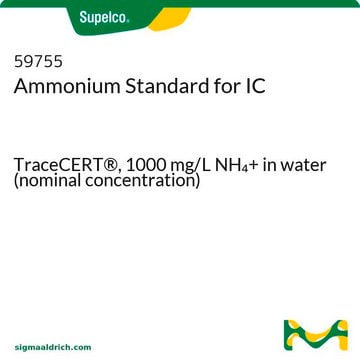11317
Acide méthanesulfonique
Fabrication pharma
About This Item
Produits recommandés
Source biologique
synthetic
Niveau de qualité
Densité de vapeur
3.3 (vs air)
Pression de vapeur
1 mmHg ( 20 °C)
Pureté
98.0-102.0% (1 M NaOH, T)
Forme
liquid
Impuretés
≤5 ppm ethyl methansesulfonate (GC)
≤5 ppm isopropyl methanesulfonate (GC)
≤5 ppm methanesulfonyl chloride (GC)
≤5 ppm methyl methanesulfonate (GC)
Résidus d'évap.
≤0.1%
Indice de réfraction
n20/D 1.429 (lit.)
Point d'ébullition
167 °C/10 mmHg (lit.)
Pf
17-19 °C (lit.)
Densité
1.475-1.485 g/mL at 20 °C
1.481 g/mL at 25 °C (lit.)
Traces d'anions
chloride (Cl-): ≤50 ppm
sulfate (SO42-): ≤200 ppm
Traces de cations
Ta: ≤5 ppm
Adéquation
corresponds for IR spectroscopy
Chaîne SMILES
O=S(O)(C)=O
InChI
1S/CH4O3S/c1-5(2,3)4/h1H3,(H,2,3,4)
Clé InChI
AFVFQIVMOAPDHO-UHFFFAOYSA-N
Vous recherchez des produits similaires ? Visite Guide de comparaison des produits
Mention d'avertissement
Danger
Mentions de danger
Conseils de prudence
Classification des risques
Acute Tox. 4 Dermal - Acute Tox. 4 Oral - Eye Dam. 1 - Met. Corr. 1 - Skin Corr. 1B - STOT SE 3
Organes cibles
Respiratory system
Code de la classe de stockage
8A - Combustible corrosive hazardous materials
Classe de danger pour l'eau (WGK)
WGK 1
Point d'éclair (°F)
372.2 °F - closed cup
Point d'éclair (°C)
189 °C - closed cup
Faites votre choix parmi les versions les plus récentes :
Déjà en possession de ce produit ?
Retrouvez la documentation relative aux produits que vous avez récemment achetés dans la Bibliothèque de documents.
Notre équipe de scientifiques dispose d'une expérience dans tous les secteurs de la recherche, notamment en sciences de la vie, science des matériaux, synthèse chimique, chromatographie, analyse et dans de nombreux autres domaines..
Contacter notre Service technique







